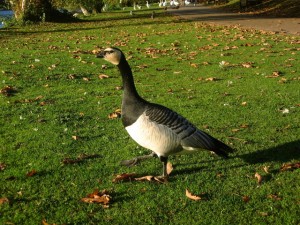TUESDAY, 1 JUNE 2010
As many dog owners attest, animals have a personality. Ecologists define animal personality as a behaviour that is consistent over time and in different contexts. In this study, 'boldness' was measured by how individual geese reacted to novel objects, such as a piece of carpet, placed near to them,. Individuals that walked close to the object were characterised as bold, 'willing to take risks'. Geese that stayed away, on the other hand, were defined as 'shy'.To find out whether and how barnacle geese use social information, the research team set up an experiment whereby all of the bold geese and the shy geese were given a 90 seconds to watch two groups of barnacle geese. One group of geese was given food, the other group was not. The behaviour of these two groups differed according to whether or not they were given food.
After watching the two groups, each goose was allowed to decide which group it wanted to join. Food was only made available to the geese on the side where the geese it had watched had been given food. They found that the shy geese were more likely to join the group that was eating. Bold individuals, on the other hand, ignored the social inofrmation and went searching for their own food.
In a follow-up experiment, the researchers tested whether the shy geese would continue to use the information even if it proved to be incorrect. Again there were two groups, one with food, the other without. However, this time the food for the geese watching was placed on the side where the geese had not been fed. They found that initially the shy geese were more likely to join the group that had been eating, but after six days of being presented with the incorrect setup they seem to be able to learn to ignore social information when choosing a group.
Most models of animal distribution assume that each individual uses social information to the same extent. This study shows that this is not the case, with animal personality playing an important part in the decision to disperse or congregate. Ideally, future models will include a range of animal personalities, which can be important for modelling the distribution of endangered species.
Written by Wing Ying Chow

